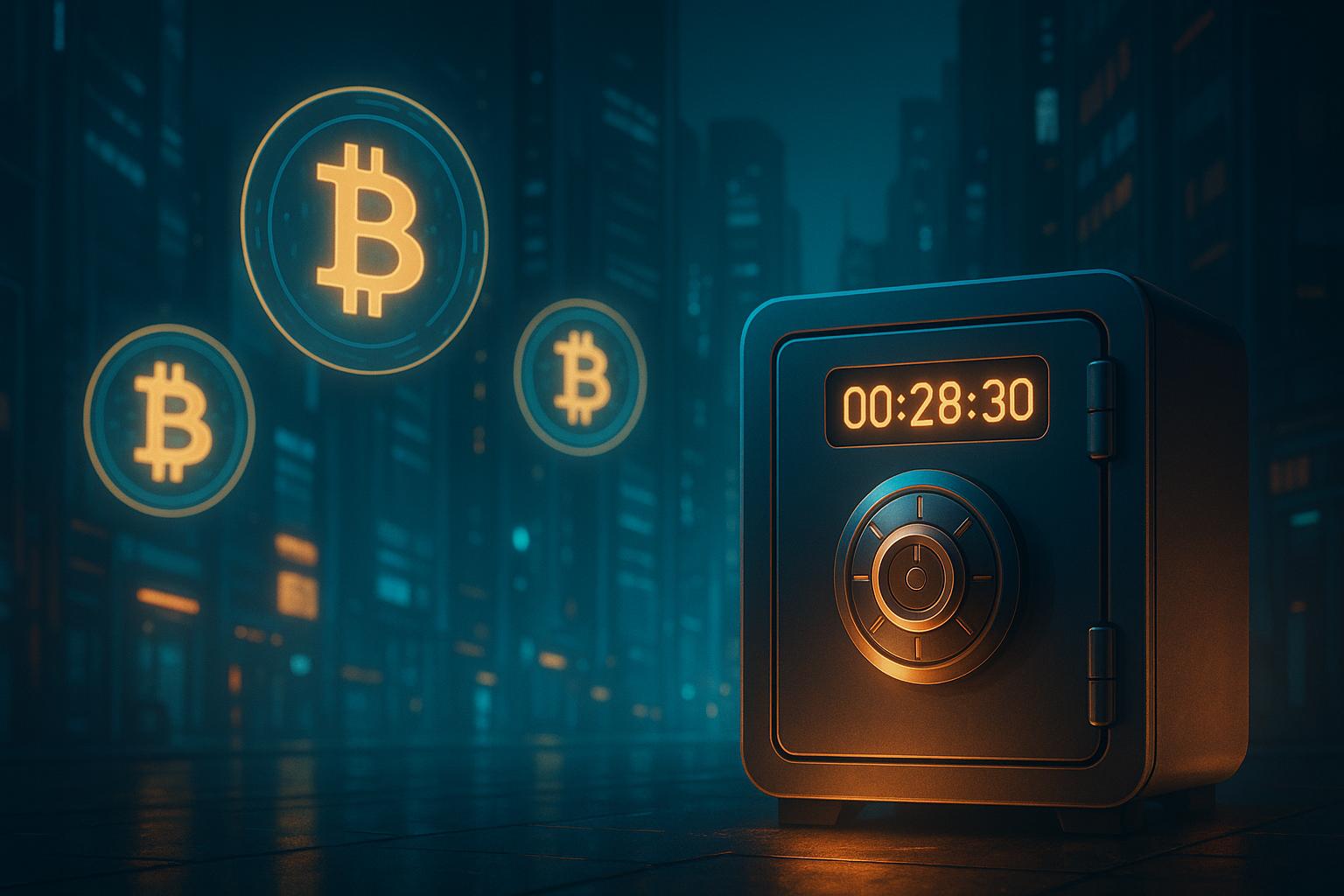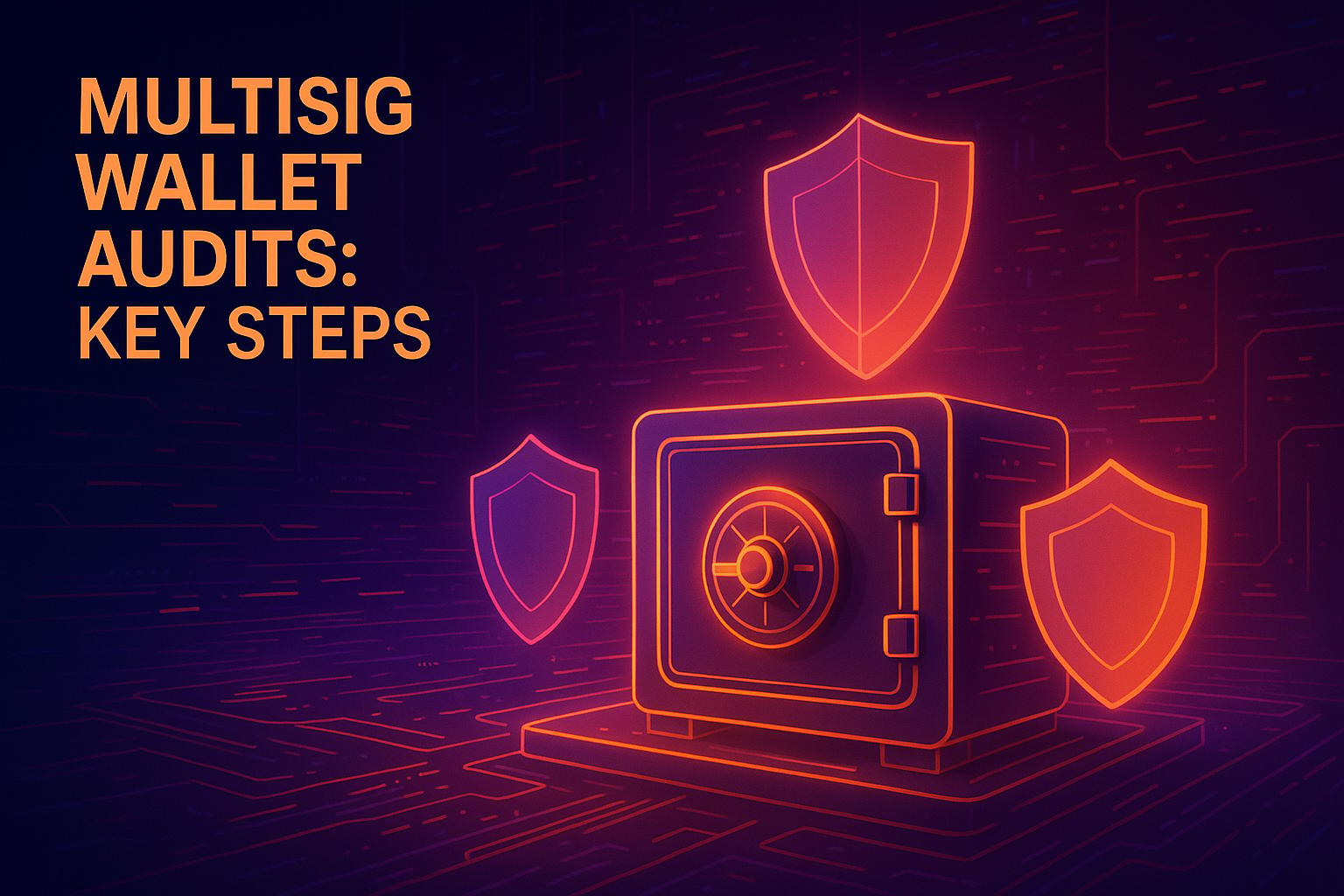Bitcoin's security has advanced significantly, addressing threats like theft and data breaches. Two key strategies are gaining attention: time-delayed transactions and secure channel protocols. Here's what you need to know:
- Time-Delayed Transactions: These use Bitcoin's natural transaction delays and timelocks to add a review window before finalizing transactions. This can help detect errors, prevent fraud, and stop unauthorized actions.
- Secure Channels: These encrypt communication between wallets and nodes, protecting sensitive data like private keys and transaction details from interception or tampering.
Why It Matters Now: As Bitcoin adoption grows, these tools provide added protection against cyber and physical threats. Together, they create a layered defense system that enhances security without compromising usability. Wallets like BitVault combine these methods, offering adjustable delays, AES-256 encryption, and integration with Bitcoin Layer 2 networks.
Bitcoin, Explained 71: Timelocks
Time-Delayed Transactions: How They Work and Security Benefits
Time-delayed transactions build on Bitcoin's natural processing delays by adding intentional review periods, giving users the ability to verify or cancel pending transactions. This added layer of control enhances security and reduces risks associated with unauthorized or erroneous actions.
The Mechanics of Time-Delayed Transactions
Time-delayed transactions leverage Bitcoin's timelocks, which are programmed to delay the finalization of a transaction based on either block height or a specific time. Wallets use these timelocks to create pre-signed transactions that remain pending until the designated period ends, giving users time to inspect and confirm them. Advanced Layer 2 solutions, like Lightning and Liquid, take this concept further by integrating timelocks into dispute resolution processes and secure multi-signature setups.
How Delays Improve Security
Introducing a delay before finalizing transactions significantly strengthens defenses against common attack methods. For example, requiring multiple confirmations prevents race attacks, where a bad actor submits conflicting transactions to cancel or alter an initial payment. Similarly, these delays make double-spending attempts more challenging by adding a buffer to detect and respond to such exploits.
Beyond technical attacks, delays address human vulnerabilities. They reduce the pressure of phishing scams or rushed decisions by allowing users time to identify and stop unauthorized transactions. If an attacker gains access to private keys or wallet credentials, the enforced delay offers a critical window for legitimate users to notice suspicious activity and act to secure their funds.
Tailoring Delay Periods to Security Needs
Modern wallets now let users customize delay periods to match their specific needs, factoring in transaction value, behavior patterns, and personal risk tolerance. For instance, high-value transactions benefit from longer delays, giving users extra time for careful review. At the same time, routine, low-risk payments can use shorter delays for convenience.
Customizable delays are also crucial for critical account updates, like changes to multi-signature configurations or recovery phrases, where added time ensures users can spot and address potential threats. By tailoring these delays, users strike a balance between security and usability.
When setting delay periods, it’s essential to consider the sensitivity of the transaction. Small, everyday payments might only need minimal delays, while significant transfers or security updates warrant longer review windows. This flexible approach not only minimizes unnecessary alerts but also empowers users to take control of their security. These delay features work hand-in-hand with secure communication protocols, creating a multi-layered defense system that will be explored further in the next section.
Secure Channel Protocols for Bitcoin Transactions
Secure channel protocols are essential for safeguarding Bitcoin transactions. They establish encrypted pathways that shield sensitive data from being intercepted or tampered with. Together with time-delayed transaction methods, these protocols create a strong, multi-layered defense against technical attacks and unauthorized access.
How Secure Channels Work
Secure channels rely on advanced encryption techniques - like AES 256-bit encryption - to create protected communication pathways between Bitcoin wallets, nodes, and other network participants.
These protocols also enable participants to authenticate each other without exposing private information. Cryptographic signatures ensure message authenticity, while secure key exchange mechanisms and Perfect Forward Secrecy maintain confidentiality. By generating unique encryption keys for each session and discarding them afterward, these methods ensure that previous communications remain secure, even if future keys are compromised.
Protecting Against Attacks and Breaches
Secure channels address several common threats to Bitcoin transactions. For example, encrypted communication and mutual authentication make it extremely difficult for attackers to carry out man-in-the-middle attacks, where they attempt to intercept or alter transaction data.
Protocols also include integrity checks to detect unauthorized changes to critical information, such as transaction amounts or recipient addresses. If any tampering is detected, the transaction is automatically flagged and rejected. Additionally, obfuscating metadata helps reduce the risk of profiling by malicious actors.
To prevent replay attacks - where attackers attempt to resend intercepted transaction data - secure channels use mechanisms like timestamps, sequence numbers, and cryptographic nonces. These ensure that every transaction communication is unique and cannot be reused maliciously.
Aligning with U.S. Security Standards
Many secure channel protocols are designed to meet the stringent requirements of Federal Information Processing Standards (FIPS), established by the National Institute of Standards and Technology (NIST). These standards outline encryption algorithms, key management practices, and security controls that are often integrated into Bitcoin wallets to meet regulatory and security expectations.
The Cryptographic Module Validation Program (CMVP) further ensures compliance with U.S. government standards. It sets requirements for random number generation, key storage, and algorithm implementation. By adhering to FIPS and CMVP standards, Bitcoin wallets demonstrate a high level of security and reliability.
For wallets like BitVault, combining secure channel protocols with time-delayed transaction features exemplifies a strong, layered approach to Bitcoin security. This alignment with U.S. standards not only reinforces security but also ensures compliance with regulatory frameworks, offering users greater peace of mind.
sbb-itb-c977069
Combining Time-Delayed Transactions and Secure Channels
Bringing together time-delayed transactions and secure channels creates a strong, multi-layered defense against both digital and physical threats. Research indicates that using these two technologies in tandem provides much stronger protection than relying on either one alone.
Research Findings on Integration Benefits
Studies highlight that combining time-delayed transactions with secure channels significantly boosts security. This integration works by using secure channels to safeguard the transmission of delay parameters and alerts, while the built-in delay acts as a buffer, allowing time for intervention. Essentially, attackers would need to bypass both the secure communication system and the time delay to succeed, making it a much tougher challenge.
Customization further enhances this integration. By tailoring encrypted notification systems, delay parameters can be adjusted to meet specific security needs, ensuring that alerts are delivered to the right people without risk of interception.
Protection Against Sophisticated Threats
This combined approach is particularly effective against advanced digital attacks and physical coercion. For instance, in scenarios where an attacker might attempt to force a key handover, secure channels ensure that alert systems remain protected, while the time delay prevents immediate unauthorized fund transfers. This delay creates a critical window for defensive action.
Comparing Different Security Methods
| Security Method | Immediate Threat Protection | Physical Attack Protection | Complexity | User Experience Impact |
|---|---|---|---|---|
| Time-Delayed Transactions Only | Limited | High | Low | Moderate delay inconvenience |
| Secure Channels Only | High | Limited | Moderate | Minimal user impact |
| Combined Integration | High | High | High | Balanced protection with manageable delays |
The combined method uses 256-bit AES encryption for secure communications and customizable delay settings that adapt to varying threat levels. While this approach involves more complex implementation, it offers robust protection that can scale to different security requirements. The table above highlights the advantages of this synergy, showing how the combined method balances strong security with practical usability.
A prime example of this strategy is BitVault's implementation. It integrates adjustable time delays with encrypted alert notifications sent to designated "owl wallets." These notifications use secure channel protocols that follow industry-standard encryption, while seamlessly working with Bitcoin Layer 2 solutions to maintain transaction efficiency and a smooth user experience[1].
Case Study: BitVault's Use of Time-Delayed Transactions and Secure Channels

BitVault combines time-delayed transactions with secure channel protocols to strengthen Bitcoin security. This open-source, non-custodial wallet is designed to protect digital assets against both physical and cyber threats while maintaining compatibility with Bitcoin's evolving ecosystem. By merging these advanced techniques, BitVault provides a practical example of how Bitcoin security can be reinforced in everyday use. Below, we explore how BitVault implements these features.
Time-Delayed Transactions in BitVault
BitVault's time-delayed transactions are designed with user flexibility in mind. Users can set customizable delay periods, granting them a window to review or cancel transactions before they are finalized. This added layer of control allows users to adapt security measures to their specific needs, offering a personalized approach to safeguarding funds.
Secure Channels and Encryption Standards
To protect sensitive communications, BitVault employs AES-256 encryption. This ensures that data, such as transaction alerts, stays private during transmission. BitVault's dedication to stringent cybersecurity practices is further demonstrated by its achievement of the CISA+ security certification, reflecting its commitment to robust encryption and secure communication protocols.
Integration with Bitcoin L2s
BitVault extends its functionality by integrating with Bitcoin Layer 2 solutions like the Liquid Network and Lightning Network. These integrations not only enhance security but also maintain seamless compatibility with Bitcoin. Additionally, BitVault optimizes Layer 1 transaction fees, helping users manage costs effectively while benefiting from advanced security measures.
Conclusion
The integration of time-delayed transactions and secure channel protocols represents a significant leap forward in Bitcoin security. These two methods complement each other by addressing different vulnerabilities: time delays allow users to review transactions before they’re finalized, while secure channels ensure encrypted data transmission to prevent interception.
Key Takeaways
Research shows these technologies enhance user control over Bitcoin holdings while offering strong encryption to protect against cyber threats. This is especially relevant for U.S.-based Bitcoin holders, who face growing risks from both online attacks and physical security breaches.
Together, these tools form a well-rounded security framework capable of addressing both immediate threats, like real-time hacking, and more complex, emerging challenges. With features like CISA+ security certification and compatibility with Bitcoin Layer 2 networks such as Liquid and the Lightning Network, BitVault exemplifies how advanced security measures can work seamlessly with functionality and interoperability. These advancements signal a promising shift in how Bitcoin security evolves within the broader cryptocurrency ecosystem.
Future Impact
Wider adoption of time-delayed transactions and secure channel protocols could redefine how Bitcoin is used and stored in the United States. As regulatory landscapes shift, these technologies may become essential for institutional Bitcoin custody solutions and everyday wallet applications.
FAQs
How do time-delayed transactions improve the security of Bitcoin transactions?
Time-delayed transactions bring an added layer of protection to Bitcoin by introducing a waiting period before funds become accessible. This mechanism allows users a crucial window to spot and address suspicious activity, like unauthorized access or potential security threats.
By delaying immediate access to funds, this feature can discourage attackers and lower the chances of successful theft. It also tackles challenges such as network congestion and transaction malleability, helping to ensure smoother and more reliable Bitcoin transactions. This method strengthens security while keeping you firmly in control of your assets.
How do secure channel protocols protect Bitcoin transactions, and why are they important?
Secure channel protocols are essential for safeguarding Bitcoin transactions. They establish encrypted and authenticated communication paths, ensuring that sensitive details - like transaction data - stay private and protected from interception or tampering by malicious actors.
These protocols rely on advanced cryptographic techniques, such as authenticated key exchanges, to generate shared secret keys. These keys are then used to encrypt the data and verify its integrity. This ensures secure communication, even over networks that may not be fully secure. By preventing eavesdropping and tampering, secure channels play a crucial role in minimizing cyber threats aimed at Bitcoin transactions.
How do time-delayed transactions and secure channels work together to improve Bitcoin security?
Time-delayed transactions and secure channels work together to strengthen Bitcoin's security, addressing some of the system's most pressing vulnerabilities.
Time-delayed transactions add a waiting period before a transaction is finalized. This gives users a crucial window to spot and cancel unauthorized transfers or fraudulent activity. It’s like having a built-in safety net that helps prevent losses from malicious attacks.
On the other hand, secure channels, such as encrypted communication protocols, ensure that transaction data stays private and unaltered while it's being sent. This means sensitive information is shielded from interception or tampering, even when transmitted over less trustworthy networks.
Together, these two measures provide Bitcoin users with stronger defenses against hacking, unauthorized access, and transaction fraud. It’s a combination that makes managing and securing funds more reliable.




